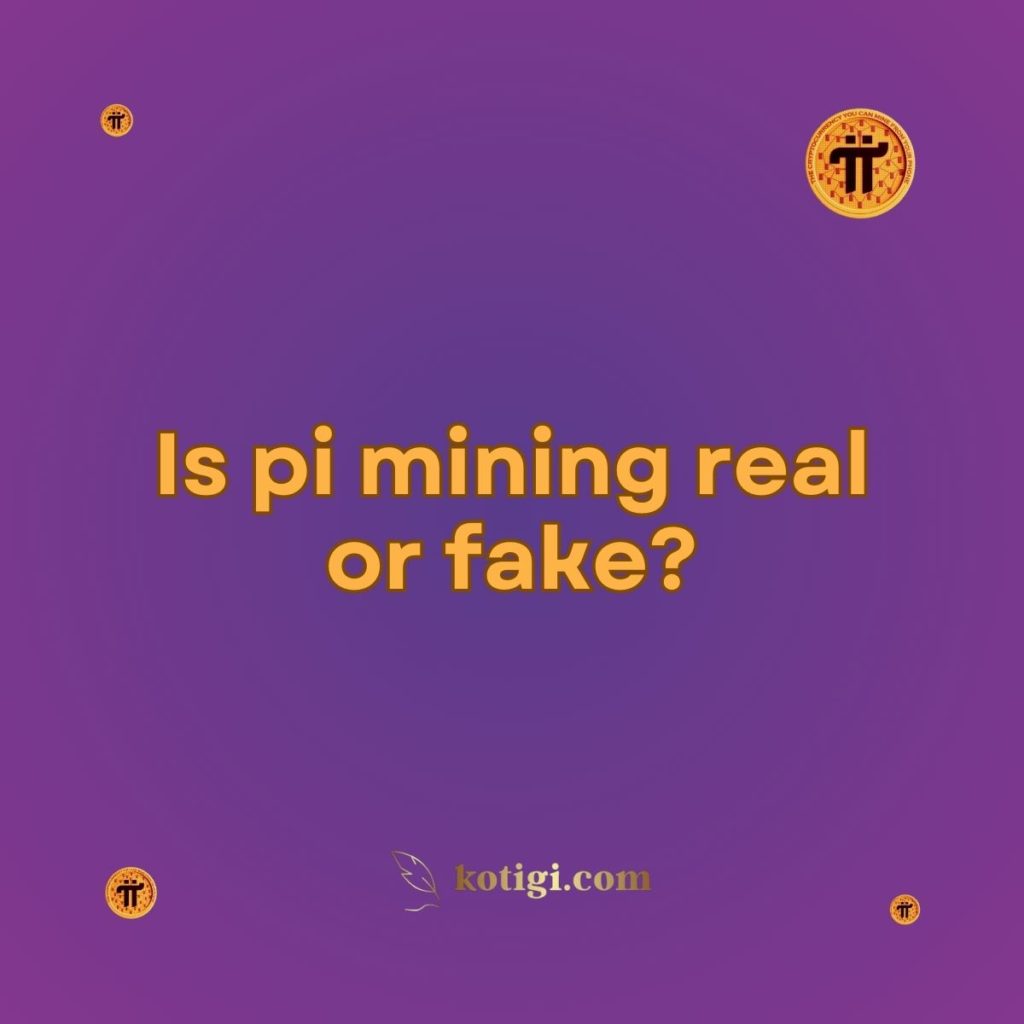
Is pi mining real or fake?
Yes, Pi mining is real. Pi Network allows users to mine Pi coins using a mobile app, which does not require significant energy or computational power, unlike Bitcoin mining. However, the true value of Pi and the project’s success remain speculative until it launches its open mainnet.
Introduction
The concept of Pi mining has generated both excitement and skepticism within the cryptocurrency community. Pi Network allows users to “mine” Pi coins using their mobile phones, a concept that has drawn many people to the project. However, questions remain: Is Pi mining real or is it just another scam in the world of digital currencies? In this article, we will break down what Pi mining is, how it works, and whether it holds legitimacy in the crypto space.
How Pi Mining Works
What is Pi Mining?
Pi mining refers to the process of earning Pi coins by participating in the Pi Network through their mobile app. Unlike traditional mining processes used by cryptocurrencies like Bitcoin, Pi Network’s mining does not require significant computational power or energy consumption. Instead, it utilizes a consensus algorithm known as the Stellar Consensus Protocol (SCP), which allows users to earn Pi coins by contributing to the security and maintenance of the network without the need for energy-intensive equipment.
In simple terms, Pi mining involves tapping a button in the Pi app once every 24 hours to keep the mining process active. This process requires no special hardware or high-end technology, making it accessible to anyone with a smartphone.
Differences from Traditional Mining
Pi mining differs significantly from traditional mining methods, such as Bitcoin mining, which uses Proof-of-Work (PoW). PoW mining involves solving complex cryptographic puzzles, which requires specialized hardware (such as ASICs) and consumes a considerable amount of electricity.
In contrast, Pi Network’s mining process leverages the power of a decentralized community of users without requiring them to solve puzzles or use excessive amounts of energy. The idea behind Pi mining is that users validate transactions and secure the network simply by being active participants, following a “lightweight” model.
Is Pi Mining Real?
Pi Network’s Approach to Mining
Pi mining is real in the sense that users can earn Pi coins by using the Pi Network app and following its rules. The project aims to create a decentralized cryptocurrency that can be used for real-world transactions, and the coins mined through the app will eventually be used within Pi’s ecosystem.
However, Pi mining is different from the traditional concept of mining, which involves using computational resources to solve cryptographic puzzles. Pi mining relies on social trust and participation, as users form security circles to validate transactions and strengthen the network.
The Current Stage of Pi Network
Currently, Pi Network is in its enclosed mainnet phase, meaning that the Pi coins being mined by users cannot yet be traded on public exchanges. The network is undergoing development and is building out its ecosystem, with the goal of launching an open mainnet in the future. Until this open mainnet is launched, Pi coins hold no monetary value, and users cannot convert them to fiat currency or other cryptocurrencies.
As a result, some people may question the legitimacy of Pi mining. While users are indeed earning Pi coins, the true value and usability of these coins will only become apparent once Pi Network reaches its full potential.
Is Pi Mining Fake?
Why Some People Think Pi Mining is Fake?
There are a few reasons why some skeptics believe Pi mining could be a scam or fake. One common criticism is that the project has yet to deliver on its promise of launching an open mainnet where Pi coins can be traded on exchanges. Without this critical step, Pi coins remain speculative, and users are unable to convert them into real-world value.
Another concern is the simplicity of Pi mining. The fact that users can earn Pi coins by simply pressing a button on their phones leads some to believe that the process is too easy to be real. Traditional cryptocurrencies like Bitcoin and Ethereum require substantial investments in hardware and energy, so the low barrier to entry for Pi mining raises eyebrows.
Addressing the Skepticism
Despite the concerns, there is no direct evidence to suggest that Pi mining is fake. Pi Network is transparent about its development process and goals, and the project has garnered millions of users worldwide. The enclosed mainnet phase is a deliberate step to ensure the network’s security and scalability before allowing public trading of Pi coins.
Moreover, Pi Network has a clear plan for KYC (Know Your Customer) verification to ensure that only real users, not bots or fake accounts, are mining Pi. This adds credibility to the project and reinforces the idea that Pi Network is not a scam but rather a long-term development effort.
The Purpose of Pi Mining
Building a User Base
One of the primary goals of Pi mining is to build a large and engaged user base before the network transitions to an open mainnet. By allowing people to mine Pi coins with minimal effort, Pi Network has successfully attracted millions of users who are now invested in the project’s future.
Securing the Network
In addition to building a user base, Pi mining serves the purpose of securing the network. Users who participate in mining form security circles, which are groups of trusted individuals that help validate transactions and ensure the network’s safety. This system relies on social trust, as users vouch for the legitimacy of one another, creating a decentralized security layer for the network.
When Will Pi Mining Be Truly Valuable?
Transition to the Open Mainnet
The true value of Pi mining will only become clear once Pi Network launches its open mainnet, allowing users to trade Pi coins on public exchanges. At that point, the mined Pi coins will have a real market value, and users will be able to convert them into fiat currency or other cryptocurrencies.
The Pi Network team has stated that they are working toward launching the open mainnet, but no specific date has been given. Until then, the value of Pi remains speculative, and users are encouraged to continue mining in anticipation of future opportunities.
Potential Use Cases for Pi
Pi Network envisions several use cases for its cryptocurrency once the open mainnet is launched. These include:
- Peer-to-peer transactions: Users will be able to send and receive Pi coins for goods and services within the Pi ecosystem.
- Decentralized applications (dApps): Pi Network aims to support the development of decentralized applications that utilize Pi coins for various purposes.
- Merchant adoption: Pi Network hopes to attract merchants who will accept Pi as a form of payment, giving the currency real-world utility.
Can You Trust Pi Mining?
Transparency of the Project
One of the factors that lend credibility to Pi mining is the transparency of the Pi Network team. The project was founded by Stanford University graduates who have been open about their goals and the challenges they face in developing the network. The team regularly communicates with the community and provides updates on the project’s progress.
User Trust and Community
Pi Network has also built a strong and engaged community of users who believe in the project’s long-term vision. While the project is still in its early stages, the sheer size of the user base and the active participation of miners suggest that Pi Network has the potential to succeed if it can deliver on its promises.
The Future of Pi Mining
Ongoing Development
Pi Network is still a work in progress, and the team continues to develop the project in preparation for the open mainnet launch. This development includes improving the KYC process, enhancing network security, and building out the Pi ecosystem.
As the project evolves, it is likely that Pi mining will become more valuable as the network grows and gains recognition in the broader cryptocurrency space.
Long-term Viability
The long-term viability of Pi mining depends on whether Pi Network can deliver a functional and decentralized ecosystem that attracts users, developers, and merchants. If the project succeeds, Pi coins mined today could hold significant value in the future. However, as with any cryptocurrency project, there are risks, and users should approach Pi mining with a cautious and informed mindset.
Conclusion
In conclusion, Pi mining is real, but it is very different from traditional cryptocurrency mining methods. Pi Network allows users to mine Pi coins with minimal effort through a mobile app, making it accessible to a wide audience. While Pi mining does not require energy-intensive processes like Bitcoin mining, it serves the purpose of building a user base and securing the network.
The true value of Pi mining will only become apparent once Pi Network launches its open mainnet, allowing users to trade Pi coins for real-world value. Until then, Pi mining remains speculative, but there is no direct evidence to suggest that it is fake. Pi Network continues to develop, and users are encouraged to remain patient and informed as the project progresses.
Key Takeaways:
- Pi mining is real but differs from traditional mining methods.
- It is a mobile-based process that requires minimal energy and computational power.
- The current value of Pi is speculative, as the project is still in its enclosed mainnet phase.
- Pi Network requires KYC for users to transfer or sell Pi coins.
- The true value of Pi mining will be realized once the network launches its open mainnet.





